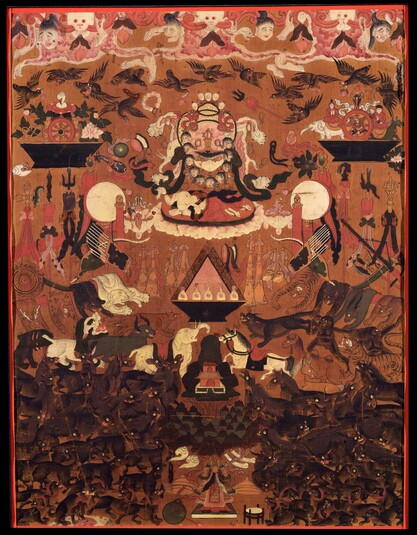
Item: Mahakala (Buddhist Protector) - Shadbhuja (Shangpa)
| Origin Location | Mongolia |
|---|---|
| Date Range | 1700 - 1799 |
| Lineages | Buddhist |
| Size | 46.99x34.93cm (18.50x13.75in) |
| Material | Ground Mineral Pigment on Cotton |
| Collection | Rubin Museum of Art |
| Catalogue # | acc.# F1996.27.11 |
Classification: Deity
Appearance: Wrathful
Gender: Male
Wrathful Offerings (Tibetan: kang dze) to the Six-handed Great Black One (Tib.: gon po chag drug pa. Sanskrit: Shadbhuja Mahakala). Displaying all the wrathful hand objects, vestments, attire and offerings that are special to Mahakala.
Tibetan: Kang dze
Located at the upper middle above a pink lotus, orange sun disc and white prone figure of Ganesh are the hand objects, garments and ornaments of the Six-handed Mahakala. In the middle is the curved knife and skullcup that are held in the first pair of hands. Surrounding that is the garland of fresh human heads, bracelets, crown of five dry skulls with red ribbons and earrings. As a backdrop are the elephant hide and long dark scarf. At the left are the remaining hand objects, a garland of skulls and a damaru hand drum; on the right a trident and lasso.
In a black bowl at the left side are the Eight Auspicious Symbols. In a bowl on the right are the Seven Jewels of Royalty. Along the top, in place of an ornate latticework and looped garlands, are hanging human skins, dangling hearts and white skulls with loops of red intestine from mouth to mouth. Below that is a flock of 13 black birds swooping and soaring with gore hanging from their beaks.
At the sides of the lotus seat are two skullcups of wrathful offerings. Below is a large pink triangular torma (stylized food) offering. Various horn instruments and weapons; spears, lances, swords, shields and the like stand at the sides, upright, leaning against a red railing. Below that is an assortment of animal pelts and hides. At the lower center is a representation of the celestial palace and below that the garb of a warrior surrounded by various instruments used to perform the worship of the wrathful protector. Surrounding all of that are wild animals, black horses, black yaks and black wolves, some as offerings and others as messengers and attendants to the protector.
These types of paintings would commonly hang in the smaller Protector temples of monasteries and represent an offering of all the symbols of a specific deity.
Jeff Watt 5-99
This tankga is known as Kangdze. It shows all the objects of offerings to please Mahakalas and Mahakalis. While here the offerings are drawn on canvas, they can also be found drawn as frescos on entire walls. These are usually in the room devoted to the protector of the monatstery (Gongkhang). At the upper part are human cadavres, under which are black crows, to the left the eight auspicious offering and to the right the seven royal emblems. In the center, the 6-armed Mahakala, invisible except for his symbolic objects and garments: damaru, rosary of skulls, trident, lassoo, and the vajra chopper and skull cup which are held by the two main hands. His head ornament is made of five skulls with a Tarchang (red scarf with earrings). The black outline with white represents his chale and hat. His other garments are an elephant skin, black sash, a necklace made of 50 freshly cut human heads, human skin and tiger skin apron. The bracelets and anklets are represented by the circles. He is trampling over Ganesha, deity of wealth, thus destroying the wordly attachment to wealth, To the left the five sense offerings (tongue-taste, nose-smell, eye-sight, ears-sound, cloth-touch). To the right, below, a skull-cup filled with blood. Next to the banners on either side are two white drums on each side, together with other musical offerings such as luths, trumpets (tongchen and gyaling), flutes and weapons (bows and arrows). Below, a torma (Mahakala tormas are often in triangular shape) with flaming edge and five smaller white tormas. Animal skins (elephant, bear, tiger, ram) and live animals (yak, yeti, snow lion, bear, horse, elephant and camel) occupy the bottom, surrounding a palace. Many black horses, yaks and dogs (the dogs should be represented with a white spot on their heart, but this is not the case here.) fill the base of the tangka. An armor is set in front, together with cymbals, conch shells, damaru, tigh bone and drum. Practionners of black Mahakala take the vow of not disturbing any black creatures (black bears, black horses, black birds), while White Mahakala practitionners do the same for white creatures. Pracitionners of other forms of Mahakala such as Gonpo Takshon (revered by Ngor Thartse Labdrang) take the vow of not disturbing tigers.
Lama Kunga Rinpoche-2/99
Collection of Rubin Museum of Art: Painting Gallery 3
Subject: Kangdze & Mount Sumeru
Subject: Offerings Main Page
Collection of Rubin Museum of Art: Mongolia
Mahakala: Shadbhuja (Offering Paintings)
Region: Mongolia, Paintings (Miscellaneous Collections)
Subject: Offering Paintings (Kangdze) Page
